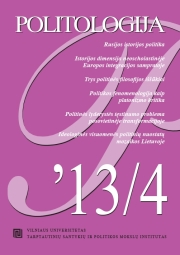POLITINĖS LYDERYSTĖS TĘSTINUMO PROBLEMA POSOVIETINĖJE TRANSFORMACIJOJE
THE PROBLEM OF POLITICAL LEADERSHIP SUCCESSION IN THE POST-SOVIET TRANSFORMATION
Author(s): Rasa ČepaitienėSubject(s): Politics / Political Sciences
Published by: Vilniaus universiteto leidykla & VU Tarptautinių santykių ir politikos mokslų institutas
Summary/Abstract: The article surveys questions related to the situation of the communist elites of allied Soviet republics during and after the collapse of the USSR. The author analizes the questions whether qualitative and quantitative changes happened in the highest layers of the power or the alterations were nominal. What actions had the major significance for the maintenance of the Soviet nomenclature power during the Soviet system’s fundamental breakdown – the character and strength of the local nomenclature’s social networks, their flexibility and adequacy when reacting to the sudden changes of the sociopolitical situation in the metropoly of the Soviet empire and in the national borderlands, the authority and personal charisma of local political leaders, the character of relationships between them and the political-administrative establishment of the centre, and with the emerging alternative local forces or more general geopolitical circumstances? The role of social groups involved into the processes of the perestroika, democratization in the change or maintenance of the communist elites are also discussed in the article. With reference to the biograms of the “last” first secretaries of the CP of allied republics, their generative, professional, and political experience is analyzed, and the given information allows to label them as “ideological” or “technocracy” wing of the party’s high nomenclature. The article shows the number of the „lasts“ first secretaries of the CP who managed not only to keep their positions and real influence in the post-Soviet transitional period, but also managed to become high officials, leaders and even presidents of new independent countries. On the basis of the Baltic countries transiting to the liberal democracy, the group of states ruled by so-called “competitive authoritarianism” and the authoritarian Central Asian republics, the article analyzes how and why national elites managed not only to adapt to the ongoing sociopolitical changes, but also had been able to control and direct them to the profitable direction. According to the latest studies of transitology and historiography of this topic, the author seeks to explain why the real scale of changes of the highest power elites of the former Soviet republics was relatively low.
Journal: Politologija
- Issue Year: 2013
- Issue No: 4 (72)
- Page Range: 119-155
- Page Count: 37
- Language: Lithuanian

